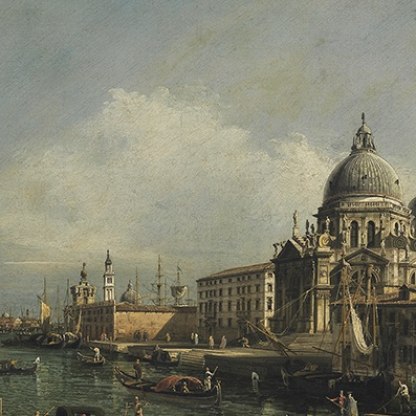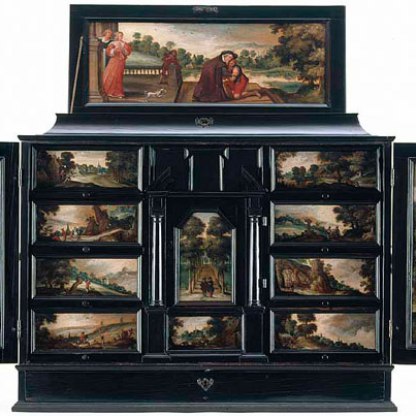Cabinet

The period of English history between 1811 and 1820 is known as the Regency. During this decade George, Prince of Wales, later George IV, acted as king during the illness of his father, George III. A cameo in the Fitzwilliam [CM.9-1980], designed by Benedetto Pistrucci in 1816, shows the 54-year-old Regent, looking like a plump Roman emperor. This was carved as a model for a medal to commemorate the arrival in England of the 'Elgin Marbles', a set of magnificent fifth-century BCE statues, taken from the Acropolis in Athens to London by Lord Elgin. During the Regency, the classical influence that had been exercised on British art and design since the middle of the eighteenth century reached its peak.
This cabinet is a work by one of the most important furniture-makers involved in this great reflowering of Greek and Roman taste. George Bullock began his career as a sculptor and wax modeller, but by 1804 was running a successful furniture business in Liverpool. While resident in the north-west, he 'discovered' the Mona marble quarry on the Welsh island of Anglesey, for which the novelist Sir Walter Scott, a friend and client, dubbed him 'the prince of black marble island'.
In 1812 Bullock moved to London, where his furniture attracted a distinguished clientele. He displayed his wares for a while in a Grecian gallery of his own design in the Egyptian Hall on Piccadilly in the heart of London, a venue for art and entertainment set up and run by his brother, William.
Although inspired by classical floral motifs and contemporary French Empire-style furniture, Bullock's cabinet in the Fitzwilliam is distinctly British in its materials and decoration. It is one of three similar pieces of furniture made for the fourth duke of Atholl to furnish his home, Blair Castle, in the Highlands of Scotland.
During the Napoleonic wars (1803–15), wood and marble from mainland Europe were difficult to come by, but Bullock made a virtue of this shortage by using wood grown on British soil and marble hewn from the British landscape.
The lighter wood in the Fitzwilliam cabinet comes from larches grown on the duke's own estate, and the contrast between this pale wood and the black ebony is typical of Bullock's work. The Glen Tilt marble surface was also taken from the duke's own land.
Bullock was praised by a contemporary critic for his use of British flora in his decoration. 'He has shewn', wrote Richard Brown, in his 1819 book The Rudiments of Drawing Cabinet Furniture, 'that we need not roam to foreign climes for beautiful ornaments, but that we have abundance of plants and flowers equal to the Grecian, which if adopted would be as pleasing as the antique.'
Ironically, Bullock, the great user of British fabrics and patterns, supplied the furniture to Longwood House, home of the exiled Napoleon Bonaparte on the remote Atlantic island of St Helena.
Bullock died suddenly in his thirties. An anonymous obituarist in a magazine of the time, praised him as one 'who carried taste, in design of furniture, to a higher pitch than it was ever carried before in this country'. But in spite of this, he swiftly fell into obscurity until the latter half of the twentieth century.
Themes and periods
Data from our collections database
Rectangular side cabinet of larchwood and ebony with gilt brass mounts and boulle work, and Glen Tilt marble top. Behind double doors the interior is fitted with two sets of six drawers on sliding runners.
Side cabinet of larchwood and ebony with gilt brass mounts and boulle work. Rectangular standing on a low plinth, the top of Glen Tilt marble, bordered on the front and sides with a brass wreath moulding. The two panelled doors each enclose six larchwood tiered drawers constructed with side runners. The doors are veneered with larchwood surrounds and a narrow border of ebony framing a boulle work panel in contre-partie of formal flower with foliage above and below. The corners of each door and of the panelled larchwood sides are decorated with applied brass mounts in the form of a stylised anthemium and scrolling leaves. The plinth is flanked at each side by free-standing turned columns of larch and ebony with bands of boulle work in premiere partie, and applied brass lotus and acanthus leaf mounts. The top of the plinth is decorated with styhlised anthemia in premiere partie boulle work, and the shaped apron and bracket supports are similarly decorated: on the front wtih a central anthemion linked to a floriated scroll at each end, and on the sides with two floriated scrolls.
The 4th Duke of Atholl; perhaps his widow as Mrs. Bagshawe, near Stafford; Mrs. C. Adams, probably of Bristol or Weston-super-Mare; Temple Williams, Ltd., Haunch of Venison Yard, Brook Strret, London, W1, from whom purchased.
Legal notes
Purchased with the Gow Fund and contributions from the National Art Collections Fund, and the Regional Fund administered by the Victoria and Albert Museum
Acquisition and important dates
- Method of acquisition: Bought
- Dates: 1980-10-13
Dating
A design among the 'Wilkinson Tracings' in the Birmingham City Museum and Art Gallery, found by the late Clive Wainwright, Department of Furniture at the Victoria and Albert Museum, shows the pattern of the boulle work on the doors of the cabinet. It is inscribed 'Mrs Barrows/Oak Book Commode/Pubd. Augt 1816'.
Bullock's dates are uncertain; his birth date may be 1782/3.
George Bullock was one of the most enterprising and original English furniture-makers of the early nineteenth century. Initially a wax modeller and sculptor, he went into business as a furnisher and marble-cutter in Liverpool in 1804, and moved to London in 1812. His success there was ensured by the superb quality of his work, which was strongly influenced by the French Empire style.
The cabinet was made for the 4th Duke of Atholl (1755-1830) and is described in Bullock's account dated 12th July 1817 as 'A Cabinet with Drawers of Larchwood the panels of Doors of Brass and ebony two columns enriched with Brass ornaments and Brass wreath moulding round the Top £45./ A slab of Glen Tilt marble at Top 6.2 @ 12/- 3.14. The price of the marble refers to the rough slab not the finished top. Its design and the materials used are closely related to two larger cabinets commissioned by the Duke, probably for Dunkeld, which were delivered in 1818, and survive at Blair Castle, Perthshire.
The cabinets illustrate prominent traits of Bullock’s style. Their rectangular forms have a strong sense of projection and recession. Smooth surfaces of dark and light woods are counterbalanced by the textured effect of coloured marble and the opulent but unostentatious glow of the mounts and brass inlay or boulle-work (a technique perfected by André Charles Boulle (1642-1732) ébeniste to Louis XIV).
- George III
- 19th Century, Early
- Production date: circa AD 1817
Maker(s)
- Bullock, George Production
Note
A design among the 'Wilkinson Tracings' in the Birmingham City Museum and Art Gallery, found by the late Clive Wainwright, Department of Furniture at the Victoria and Albert Museum, shows the pattern of the boulle work on the doors of the cabinet. It is inscribed 'Mrs Barrows/Oak Book Commode/Pubd. Augt 1816'.
Bullock's dates are uncertain; his birth date may be 1782/3.
George Bullock was one of the most enterprising and original English furniture-makers of the early nineteenth century. Initially a wax modeller and sculptor, he went into business as a furnisher and marble-cutter in Liverpool in 1804, and moved to London in 1812. His success there was ensured by the superb quality of his work, which was strongly influenced by the French Empire style.
The cabinet was made for the 4th Duke of Atholl (1755-1830) and is described in Bullock's account dated 12th July 1817 as 'A Cabinet with Drawers of Larchwood the panels of Doors of Brass and ebony two columns enriched with Brass ornaments and Brass wreath moulding round the Top £45./ A slab of Glen Tilt marble at Top 6.2 @ 12/- 3.14. The price of the marble refers to the rough slab not the finished top. Its design and the materials used are closely related to two larger cabinets commissioned by the Duke, probably for Dunkeld, which were delivered in 1818, and survive at Blair Castle, Perthshire.
The cabinets illustrate prominent traits of Bullock’s style. Their rectangular forms have a strong sense of projection and recession. Smooth surfaces of dark and light woods are counterbalanced by the textured effect of coloured marble and the opulent but unostentatious glow of the mounts and brass inlay or boulle-work (a technique perfected by André Charles Boulle (1642-1732) ébeniste to Louis XIV).
Place(s) associated
- London
Other highlight objects you might like
Suggested Curating Cambridge products
Sign up to our emails
Be the first to hear about our news, exhibitions, events and more…





